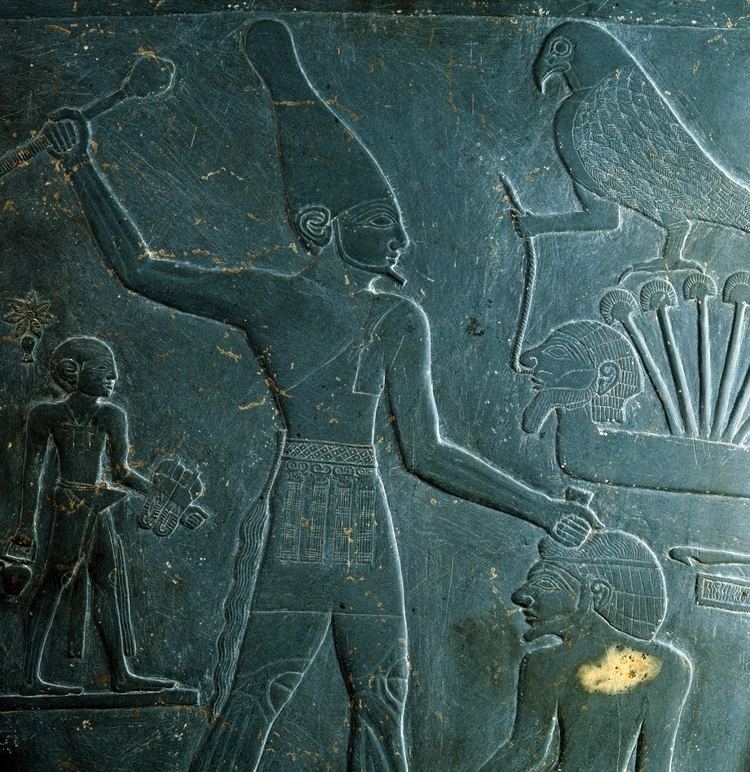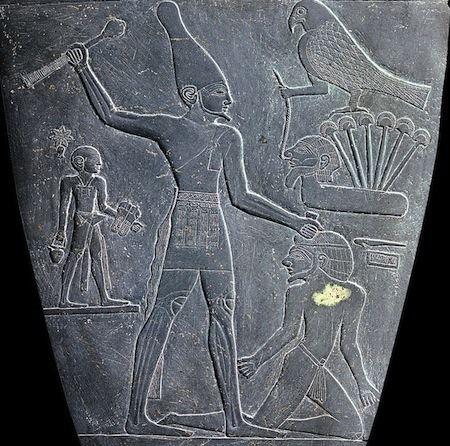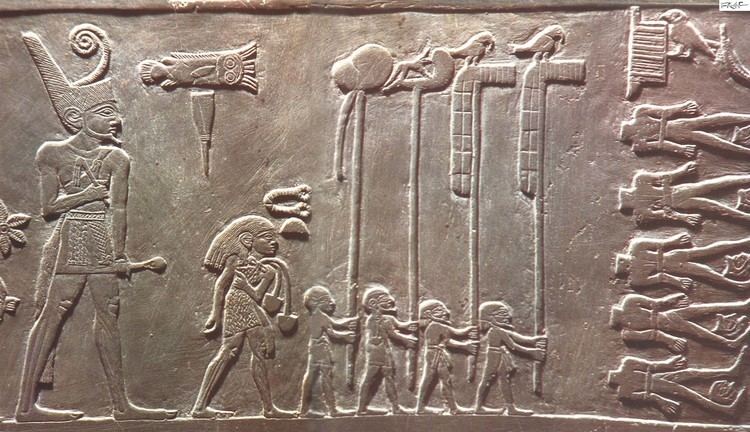Parents Shesh Ire | Buried Umm El Qa'ab, Egypt | |
 | ||
Reign c. 31st century BC(?) (1st Dynasty) Similar Menes, Djoser, Hor‑Aha, Menkaure, Khafra | ||
King narmer king before pharaoh s
Narmer was an ancient Egyptian king of the Early Dynastic Period. Probably the successor to the Protodynastic kings Scorpion and/or Ka, some consider him the unifier of Egypt and founder of the First Dynasty, and in turn the first king of a unified Egypt.
Contents
- King narmer king before pharaoh s
- King narmer and dynasty 1
- Was Narmer Menes
- Narmer and the unification of Egypt
- Niethhotep
- Tomb and artifacts
- In the popular culture
- References

Narmer's identity is the subject of ongoing debate, although mainstream Egyptological consensus identifies Narmer with the First Dynasty pharaoh Menes, who is also sometimes credited with the unification of Egypt, as the first Pharaoh. This conclusion is based on the Narmer Palette (which shows Narmer as the unifier of Egypt) and the two necropolis seals from the necropolis of Abydos that show him as the first king of the First Dynasty.

The date commonly given for the beginning of his Reign is c. 3100 BC. Other mainstream estimates using both the Historical Method and radiocarbon dating are in the range 3273 - 2987 BC.

King narmer and dynasty 1
Was Narmer Menes?

Although highly inter-related, the question of “who was Menes?” and” Who unified Egypt?” are actually two separate issues. Narmer is often credited with the unification of Egypt by means of the conquest of Lower Egypt by Upper Egypt. While Menes is traditionally considered the first king of Ancient Egypt, Narmer has been identified by the majority of Egyptologists as the same person as Menes. Although vigorously debated (Hor-Aha, Narmer’s successor, is the primary alternative identified as Menes by many authorities), the predominant opinion is that Narmer was Menes.

The issue is confusing because “Narmer” is a Horus name (throne name), while “Menes” is a personal name (birth name). All of the King Lists which began to appear in the New Kingdom, list the personal names of the kings, and they all begin with Menes, or begin with divine and/or semi-divine rulers, with Menes as the first “human king”. The difficulty is aligning the contemporary archaeological evidence which lists Horus Names with the King Lists that list personal names.
Two documents have been put forward as proof either that Narmer was Menes or alternatively Hor-Aha was Menes. The first is the “Naqada Label” which shows a serekh of Hor-Aha next to an enclosure inside of which are symbols that have been interpreted by some scholars as the name “Menes”. The second is the seal impression from Abydos that alternates between a serekh of Narmer and the chessboard symbol, “mn”, which is interpreted as an abbreviation of Menes. Arguments have been made with regard to each of these documents in favor of Narmer or Hor-Aha being Menes, but in neither case, are the arguments conclusive.
Two necropolis sealings, found in 1985 and 1991 in Abydos, in or near the tombs of Den and Qa’a, show Narmer as the founder of the First Dynasty, followed by Hor-Aha. The Qa’a sealing lists all eight of the kings of the First Dynasty in the correct order starting with Narmer. These necropolis sealings are strong evidence that Narmer was the first king of the First Dynasty – hence is the same person as Menes .
Narmer and the unification of Egypt
The famous Narmer Palette, discovered by James E. Quibell in the 1897-1898 season at Hierakonpolis, shows Narmer wearing the crown of Upper Egypt on one side of the Palette, and the crown of Lower Egypt on the other side, giving rise to the theory that Narmer unified the two lands. Since its discovery, however, it has been debated whether the Narmer Palette represents an actual historic event or is purely symbolic. Of course, the Narmer Palette could represent an actual historical event while at the same time having a symbolic significance.
In 1993, Günter Dreyer discovered, in Abydos, a “year label” of Narmer depicting the same event that is depicted on the Narmer Palette. (In the First Dynasty, years were identified by the name of the king and an important event that occurred in that year. A “year label” was typically attached to a container of goods and included the name of the king, a description or representation of the event that identified the year, and a description of the attached goods.) This year label shows that the Narmer Palette depicts an actual historical event
Archaeological evidence suggests that Egypt was at least partially unified during the reigns of Ka and Iry-Hor (Narmer’s immediate predecessors), and perhaps as early as Scorpion I (several generations before Iry-Hor) . But there is a substantial difference in the quantity and distribution of inscriptions with the names of those earlier kings in Lower Egypt and Canaan( which was reached through Lower Egypt), compared to the inscriptions of Narmer. The archaeological evidence suggest that the unification began before Narmer, but was completed by him through the conquest of a polity in the North-West Delta as depicted on the Narmer Palette.
The importance that Narmer attached to his “unification” of Egypt is shown by the fact that it is commemorated not only on the Narmer Palette, but on a cylinder seal, the Narmer Year Label, and the Narmer Boxes; and the consequences of the event are commemorated on the Narmer Macehead. The importance of the unification to ancient Egyptians is shown by the fact that Narmer is shown as the first king on the two necropolis seals, and under the name Menes, the first king in the later King Lists. Although there is archaeological evidence of a few kings before Narmer, none of them are mentioned in any of those sources. It can be accurately said that from the point of view of Ancient Egyptians, history began with Narmer and the unification of Egypt, and that everything before him was relegated to the realm of myth.
Niethhotep
Until recently, Narmer's wife was thought to have been Neithhotep, whose name means "Neith is satisfied". In this theory, she would have been a princess of Lower Egypt. Inscriptions bearing her name were found in tombs belonging to Narmer's immediate successors Hor-Aha as well as Djer, which Egyptologists took to suggest that she was the mother of Hor-Aha. However, the discovery in 2012 of rock inscriptions in Sinai during an expedition under the authority of Pierre Tallet raise questions about this theory.
Tomb and artifacts
Narmer's tomb is composed of two joined chambers (B17 and B18) found in the Umm el-Qa'ab locality, near Abydos in Upper Egypt. It is located next to the tomb of Ka, who likely ruled Upper Egypt just before him.
Narmer is well attested throughout Egypt, southern Canaan, and Sinai: altogether 98 inscriptions at 27 sites. At Abydos and Hierakonpolis Narmer's name appears both within a serekh, and without reference to a serekh. At every other site except Coptos, Narmer's name appears in a serekh. In Egypt his name has been found at 17 sites: four in Upper Egypt (Hierakonpolis, Naqada, Abydos , and Coptos); ten in Lower Egypt (Tarkhan, Helwan, Zawyet el'Aryan, Tell Ibrahim Awad, Ezbet el-Tell, Minshat Abu Omar, Saqqara , Buto , Tell el-Farkhan and Kafr Hassan Dawood ); one in the Eastern Desert (Wadi el-Qaash); and two in the Western Desert (Kharga Oasis and Gebel Tjauti). During Narmer's reign, Egypt had an active economic presence in southern Canaan. Pottery sherds have been discovered at several sites, both from pots made in Egypt and imported to Canaan and others made in the Egyptian style out of local materials. The latter discovery has led to the conclusion that Egypt's presence in Canaan was in the form of a colony rather than just the result of trade. While Egypt's presence in Canaan has been explained as the result of a military invasion, this view is not generally accepted. Fortifications at Tel es-Sakan dating to this period and almost entirely Egyptian in construction suggest a military presence, if not a military invasion.
The extent of Egyptian activity in southern Canaan is shown by the discovery of 33 Serekhs on pottery sherds at sites in Canaan dating from the Protodynastic Period to the beginning of the First Dynasty. Twenty of these may belong to Narmer, but seven of those are uncertain or controversial. [5] These serekhs came from nine different sites: Tel Arad, En Besor (Ein HaBesor), Tel es-Sakan, Nahal Tillah (Halif Terrace), Tel Erani (Tel Gat), Small Tel Malhata, Tel Ma'ahaz, , Tel Lod, and Lahav. An additional serekh from Tel Lod is attributed to Narmer's probable predecessor, Ka. Significantly only one is attributable to Narmer's successors, to Hor Aha, his immediate successor. The remainder of the serekhs either have no name on them or have a name not attributable to any known pharaoh. Narmer's serekh, along with those of other Predynastic and Early Dynastic kings, has been found at the Wadi 'Ameyra in the southern Sinai, where inscriptions commemorate Egyptian mining expeditions to the area.
During the summer of 1994, excavators from the Nahal Tillah expedition, in southern Israel, discovered an incised ceramic sherd with the serekh sign of Narmer. The sherd was found on a large circular platform, possibly the foundations of a storage silo on the Halif Terrace. Dated to c. 3000 BCE, mineralogical studies of the sherd conclude that it is a fragment of a wine jar which had been imported from the Nile valley to Canaan.
After about 200 years of active presence in Canaan, Egyptian presence peaked during Narmer's reign and quickly declined after that.
